It was worth waiting for.
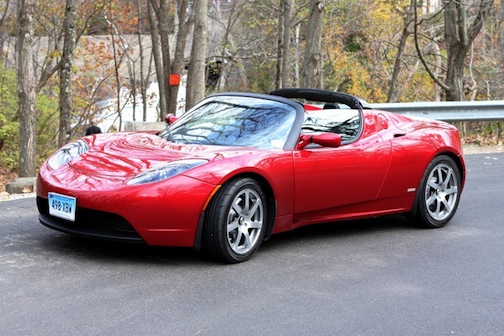
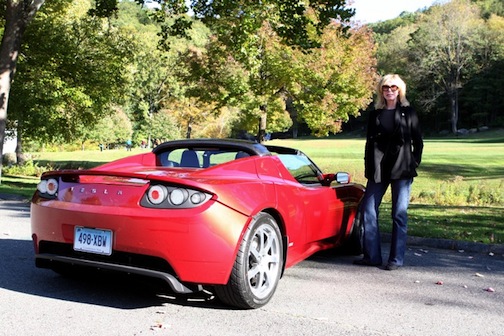
Because of the imminent trip abroad, I only had a few hours to test drive it. And then, after returning home from London, once again I had only a short time to drive it before heading off for New Orleans for the opening ofProspect.1, the new international art biennial. So here are my initial impressions.
Before taking it on public roads, I had to make the dreaded trip to the nearest Connecticut Department of Motor Vehicles office to get license plates. What a contrast that was – registering a 21st-century automobile with a 19th-century government process. Finally, after two hours tortuous waiting, I got the plates, rushed home and then started fulfilling my electric-sports-car odyssey.
The bottom line
It’s an exhilarating experience. The outstanding feature, as compared with any other car I’ve ever owned, sports cars included, is the remarkable acceleration at any speed. It springs away from a standing start. At speed, it passes other vehicles effortlessly. It is quite simply a terrestrial rocket ship.
Perhaps the other outstanding feature is one that I’m reminded of by the “curious incident of the dog that didn’t bark” (in the Sherlock Holmes mystery Silver Blaze). That feature, of course, is the Tesla’s sound, or rather, the lack of it. Curiously, there is just no sound. You would expect a high-performance sports car to make itself known, to roar, to growl. Not this one; it doesn’t even purr. It is spookily quiet (until high speed when the wind noise comes into play).
This sexy-looking car definitely draws a crowd. It’s just over 3½ feet high, seductively styled, very attractive. What’s surprising to me is how many people who encounter it actually recognize it as a Tesla. Clearly the company’s PR campaign has had an impact – e.g., 60 Minutes last month, Time Magazine this week, which in its 50 Best Inventions of the 2008 feature selected the Roadster as the No. 2 invention.
About the Roadster
Whenever I park, a crowd gathers and I’m always asked the same questions about its acceleration, speed, range, energy source, gearing, recharge time, price, weight, availability, factory, name, origin. I’m considering printing up a card with the following answers:
Acceleration: The promised spec is 0-60 mph in 3.9 seconds. While I’ve yet to confirm this with actual measurement, I suspect from my whiplash it’s very close to that. (I just downloaded an application on my iPhone that promises to measure the 0-60mph time. We’ll see.)
Speed: 125mph max, electronically limited.
Range: The nominal range is 225 miles. I haven’t had a chance to confirm this yet. The main concern with range is that you want to make sure you have enough energy left in the batteries to be able to return to your charging base. When a 110V portable recharger becomes available soon, it’ll make me a little less nervous about straying more than 100 miles from home base. (Our Connecticut-to-Manhattan distance is 87 miles – just about at the cusp of my confidence.)
Energy source: The reason for the remarkable acceleration, which compares favorably with the highest-price, most powerful sports cars in the world, is that the Tesla is powered by a 185kW (248 HP) electric motor, with the energy stored in 6,831 lithium-ion batteries.
An electric motor has the salutary characteristic of providing 100% of its torque at zero rpm. This contrasts with an internal combustion engine whose maximum torque lies in the middle of its rpm range. As the chart below shows, the Tesla delivers high torque (red line) from zero to 6,000 rpm, and high power (blue line) up to its 14,000 rpm redline. (The black line is an internal-combustion torque curve.)

Gearing: A conventional engine requires complex gearing to provide high torque from a standing start. The Tesla has a single gear – zero to 125 mph without shifting, either manually or automatically.
Recharge time: At present, recharging is only available at 220 V. A portable 110V adapter kit will be available soon. In the meantime, I had to install a dedicated 220V, 90-amp line in the garage (at no trivial expense). When fully discharged, the batteries will recharge in 3.5 hours (at 110 V, the recharge time from full discharge could exceed 24 hours.)
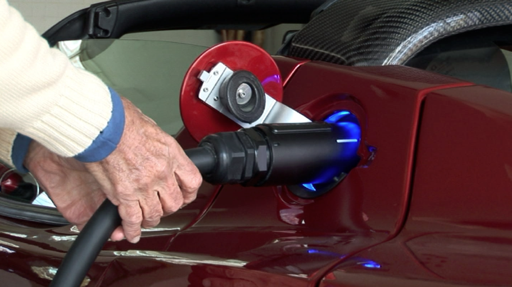
220V recharging cable
Price: Originally $100,000, now $109,000. The forthcoming Model S sedan, scheduled for 2011 delivery, will be less than half that price.
Weight: 2,732 pounds, of which 992 pounds are batteries.
Availability: The company has delivered 50 cars to date, and is now producing them at the rate of 10 per week. With a backlog of 1,200 orders, Tesla’s plan is to increase the rate to 30 to 40 per week in the spring.
Why is it called Tesla? The company name pays homage to Nikola Tesla, one of the great and prolific inventors in American history. The Serbian scientist-engineer arrived in the United States in the late 1800s to work with Thomas Edison, only to have a bitter falling out with him. (The Tesla-Edison rivalry is one of the great stories waiting to be dramatized – the foreign PhD who converted theory into practice, versus the self-taught empiricist Edison, who favored endless laboratory experimentation.) Tesla invented many of the seminal products in technological history, including the induction motor, the alternating current transmission system, and wireless radio (Marconi unfairly received a patent first, but Tesla’s invention actually preceded Marconi’s. Tesla was vindicated, and awarded the patent, some 50 years later).
Where is it made? The body, a modified Lotus Elise sports car, is manufactured in England. The powertrain is made and final assembly performed in San Carlos, California. The Model S will be manufactured in San Jose, California.
Ancillary benefits of Tesla ownership
No sales tax: Because it’s an alternative energy vehicle, the Connecticut 6% sales tax is waived. (This benefit varies state to state.)
High-occupancy vehicle lanes are available even with a single passenger.
No fluids to check or oil to change. No oil filters or air filters to change.
Good citizen. The satisfaction of knowing that one is making a small contribution toward reducing greenhouse gases, noxious emissions and petroleum consumption.
My concerns
Range is clearly an issue until the portable 110V recharger becomes available. Until then, I plan to stay relatively close to home.
The interior space is, shall we say, snug. It’s a bit of a challenge to get into the car, and a bit more of a challenge to get out, particularly if the top is on.
The trunk space is limited. The good news is that the trunk will hold one set of golf clubs; the bad news is that’s allit will hold.
Start-ups and giants:
Aptera: Last weekend, we were in Carlsbad, California, for a Caltech board retreat. Carlsbad also happens to be the home of Aptera Motors. Aptera, it turns out, is funded by Idealab, a company headed by my friend and fellow Caltech board member, Bill Gross. Bill arranged for me to get a test drive in the prototype Aptera electric car. Slated for 2009 delivery in both all-electric and range-extended hybrid versions, this radically designed three-wheel vehicle wins the space-age-looks award. It is a show-stopper. With a remarkably low coefficient of drag of 0.15, the car promises outstanding efficiency. Prices are expected to start at $27,000.
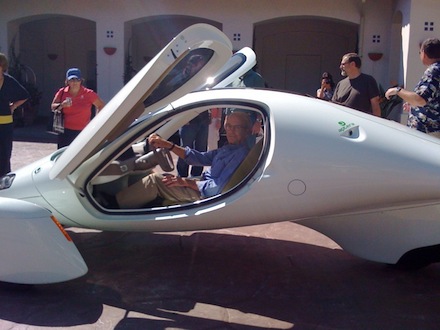
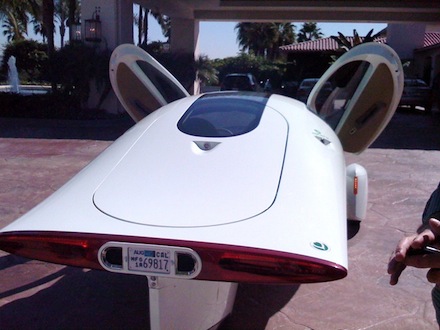
Aptera prototype
Chevy Volt: This 4-to-5 seat series hybrid, or range-extended electric car, is General Motors’ big bet on the future. It hopes to ship in 2010, or just before Tesla ships its Model S sedan.
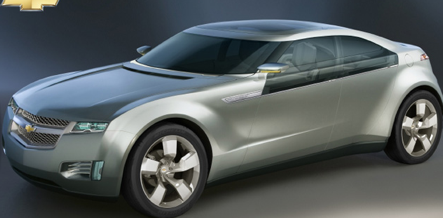
Chevy Volt
Other competitors: Many of the world’s leading auto manufacturers are also moving toward developing some type of electric and/or series-hybrid car. One should not underestimate their resolve to compete in this new technology marketplace. We who came up through the high-tech industries, and at one time had our sights on taking on the auto industry, tend to underestimate the ability of the auto industry to make very-high-volume products with very high functionality at very low cost. They have over 100 years experience down the learning curve, and have gotten pretty good at this type of manufacturing. They also have a huge amount of capacity available in which they could ramp up pretty quickly -- if they bring out the right products at the right price.
Tesla’s opportunity
Is there then a place for a start-up to compete with this potential electric-car onslaught from the Big Guys? Well, the Tesla Roadster reminds me a lot of my experience with the Compaq Portable. The latter was our beachhead into the computer industry in 1983, an industry that was then dominated by the IBM desktop. We as a start-up couldn’t compete head-on with IBM by selling desktops to corporate customers. We needed to create something that IBM didn’t have. So we introduced a product that was differentiable, one that IBM didn’t offer – a portable computer. A year later, when we had the beachhead established – broad corporate customer base, established channels of distribution, high-volume and low-cost manufacturing capability, in-depth engineering team, worldwide supply chain, international brand name – we could then move on to compete head-on with IBM in desktops. Which we did. Successfully.
Similarly, the Roadster is Tesla’s beachhead into the automotive business. Tesla makes electric cars; the establishment makes internal-combustion-engine vehicles. Tesla has two years to establish all those corporate capabilities required to compete with the giants when they finally invade Tesla’s turf. Compaq was able to do it against a pretty formidable competitor and go from start-up to a $40 billion company in two decades. Tesla has the same opportunity.
In the meantime I’m really happy that Tesla Motors brought out the Roadster. I’m having a hell of a good time with it, even though I’m apparently driving it too cautiously -- I haven’t got a single ticket yet.
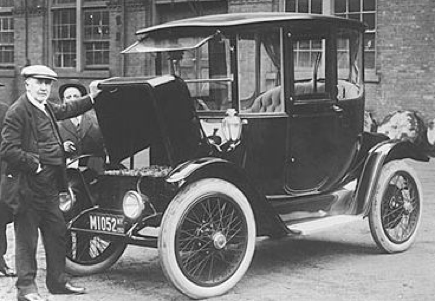
Electric car predecessor to the Tesla Roadster, circa 1900


